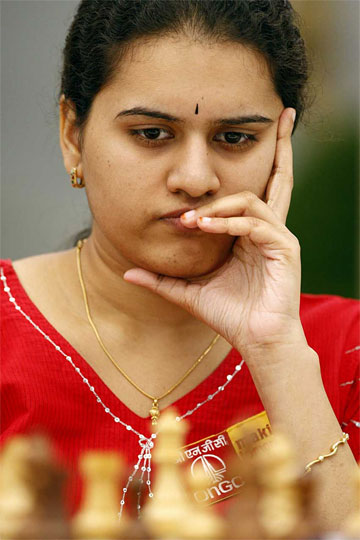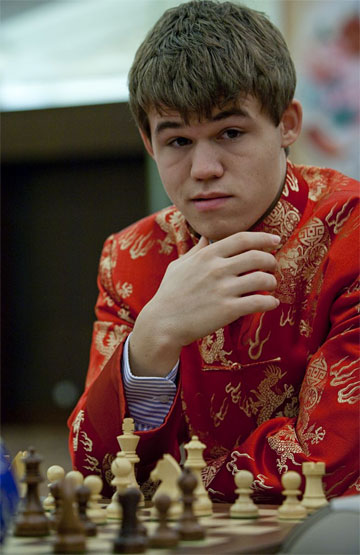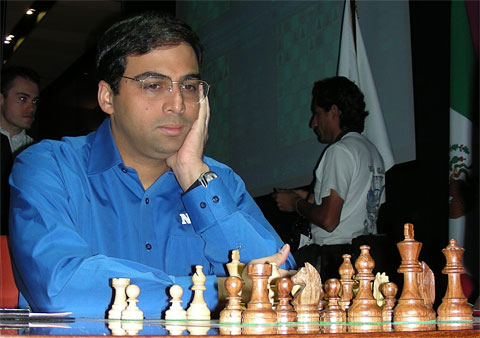| Latest | Greatest | Lobby | Journals | Search | Options | Help | Login |
|
|
|
This topic is archived. |
| Home » Discuss » Topic Forums » Sports |
|
| Jack Rabbit
|
Sun Feb-07-10 03:22 PM Original message |
| The JR Chess Report (Super Sunday Edition): Adams wins in Gibraltar; Zhukova takes ladies' top prize |
|
Edited on Sun Feb-07-10 03:24 PM by Jack Rabbit
Mickey Adams Wins Gibraltar in Playoff; Zhukova Takes Ladies' Prize
 The 2010 Master's Open of the eighth annual Gibtelecom Chess Festival ended Thursday with British grandmaster Mickey Adams winning a four-way blitz playoff against Paco Vallejo, Jan Gustafsson and Chandra Sandipan, while Ukraine's Natalia Zhukova, the wife of reigning Russian national champion Alexander Grischuk, won the tournament's coveted women's prize. Adams had been at or near the top from wire to wire. His 7� points out of the scheduled ten rounds were matched by eight other players, with the top four palyers by tie break going to the blitz rounds. The five players who scored 7� points who did not qualify were grandmasters Gata Kamsky, Etienne Bacrot, Sergei Movsesian, Geetha Narayanan Gopal and American international master Alex Lenderman. The playoff was held immediately after completion of the final round. In the first round of mini-matches, Mr. Adams was paired with Herr Gustafsson and el se�or Vallejo took on Sandipan Shahib. El se�or Vallejo won the first game and held Sandipan to a draw in the second, thus earning the right to go through to the final. Mr. Adams lost his first game to Herr Gustafsson, but took advantage of a blunder to win the second, setting up an armageddon game in which Adams played White and was obligated to win. Adams succeded in defeating Gustafsson in 46 moves, setting up the final match between Admas and Vallejo. Adams won the first game and drew the second to claim the tournament championship. Ms. Zhukova played a whale of a tournament scoring 7 points to win the women's prize and a grandmaster norm. She played on the top board and drew against Adams in the seventh round and entered round eight still tied for first place when she lost to Gustafsson. She bounced back in round nine to defeat reinging world women's champion Alexandra Kosteniuk and drew her final game to edge out the second ranked woman in the world, grandmaster Koneru Humpy of India, for the top woman's prize. Journeyman GM Wins Moscow Open  Russian grandmaster Konstantin Chernyshov, the tournament's 46th seed with an Elo score of 2556, won the Moscow Open today with 7 points in nine rounds after drawing his final game against young Vietnamese grandmaster Le Quang Liem. Le, Russian veteran Evgeny Bareev and Russian GM Ernesto Inarkiev also scored 7 points with Chernyshov taking the tile on a superior tie break score. In the women's tournament, sixteen-year-old Nazi Pakidze edged out her fellow Georgian Salome Melia on tie beaks to take first place. Both ladies scored 7� points out of a passible nine. (Ms. Pakidze's first name is the Georgian equivalent of Natalie and not a practical joke played on her by her parents.) Both won their final games today; Ms. Pakidze defeated reinging Russian girls' champion Valentina Guinina while Ms. Melia took down Chinese grandmaster Zhao Xue, who entered the final round with 7 points, a half point ahead of the field. Aeroflot Open Begins Tuesday  The ninth annual Aeroflot Open, the most prestigious open tournament on the chess calendar, begins Tuesday in Moscow. As of now, the top seed is the defending tournament champion, French grandmaster Etienne Bacrot. Bacrot edged out Slovenian GM Alexander Moiseenko on tie breaks to win last year's edition. Moiseenko will also be present this year. The winner of the Aeroflot Open will again be seeded to the Dortmund Sparkassen this summer. Bundesliga: Baden Baden Storms through Berlin  The mighty team from the Baden Baden Chess Club played this weekend in Berlin and maintained its perfect score with 18 match points to lead the German Bundesliga with a perfect score after 9 matches. Baden Baden defeated the K�nigs Tegel Chess Club from Berlin today by a score of 6�-1�. Yesterday, Baden Baden skunked the Berlin Chess Federation team, 8-0. Etienne Bacrot, Jan Gustafsson, Arkadik Naiditsch, Liviu-Dieter Nisipeanu and Fabiano Caruana each scored victories in both matches to contribute to Baden Baden's success this weakend. The team from Solingen, whom Baden Beden defeated in the first round this season in October, is in second place with 16 match points. Mickey Adams, also in from Gibraltar, also scored a point and a half for Baden Baden over the weekend. On the weekend of February 27 and 28, Baden Baden will be in Heidelburg to play against Breman and Hamburg. Calendar 27th Ciudad de Linares 12-25 February. Aronian, Gashimov, Gelfand, Grischuk, Topalov and Vallejo. Reykjavik Open 24 February-3 March. Bundesliga 0910, Rounds 10-11, M�lheim, Heidelburg, Solingen, Trier. 27-28 February. European Individual Championships, Rijeka (Croatia) 5-19 March. Melody Amber Rapid/Blindfold Tournament, Nice. 12-25 March. Aronian, Carlsen, Dom�nguez, Gelfand, Gashimov, Ivanchuk, Karjakin, Kramnik, Morozevich, Ponomariov, Smeets and Svidler. Philadelphia Open 31 March-4 April. This replaces the Foxwoods Open after the Foxwoods Resort announced expected room rate hikes. Russian Team Championships, Dagomys 1-12 April. Women's Grand Prix, Nalchik 23 April-6 May. Anand-Topalov Match for the World Title, Sofia 23 April-10 May. Grand Prix, Astrakhan (Russia) 9-25 May. US Championship, St. Louis 13-25 May. Chicago Open 27-31 May. Women's Grand Prix, Jermuk 23 June-6 July. World Open, Valley Forge, Pennsylvania 29 June-5 July. Women's Grand Prix, Ulan Bator (Mongolia) 29 July-12 August. World Junior Championships, Chotowa Czarna (Poland) 2-17 August. Chess Olympiad, Khanty Mansiysk 19 September-4 October. European Club Cup, Plovdiv 16-24 October. Women's Grand Prix, Vina del Mar (Chile) 27 October-9 November. World Youth Championships, Halidiki (Greece) 19-31 October. FIDE Women's Knock Out (Women's World Championship), Turkey 2-25 December. |
| Printer Friendly | Permalink | | Top |
| Jack Rabbit
|
Sun Feb-07-10 03:26 PM Response to Original message |
| 1. This week's games |
|
Your humble hare acknowledges the assistance of Fritz 6.0 on analysis. Diagrams on the Jack Rabbit Chess Report are made with Chess M�rida, a true type font that can be downloaded free here. !""""""""# $tMvWlVmT% $OoOoOoOo% $ + + + +% $+ + + + % $ + + + +% $+ + + + % $pPpPpPpP% $RnBqKbNr% /(((((((() WHITE White to move (This position is a theoretical draw) I would like to thank my impressive and loyal staff: Buccaneer, Spitfire, Swashbuckler, Pancho and Robin Hood. |
| Printer Friendly | Permalink | | Top |
| Jack Rabbit
|
Sun Feb-07-10 03:27 PM Response to Reply #1 |
| 2. Gibtelecom Masters' Open, Gibraltar |
 Some of Gibraltar's native inhabitants know instinctively what to do with weapons of war |
| Printer Friendly | Permalink | | Top |
| Jack Rabbit
|
Sun Feb-07-10 03:31 PM Response to Reply #2 |
| 5. Adams - Lemos, Round 9 |
 Mickey Adams Mickey Adams - Damian Lemos 8th Gibtelecom Masters' Open, Round 9 Gibraltar, 3 February 2010 Open Sicilian Game: Four Knights' Opening 1.e4 e6 2.d4 d5 3.Nd2 Be7
4.Ngf3
4...Nf6 5.e5 Nfd7 6.Bd3 c5 7.c3 b6 8.0-0
8...Ba6 9.Ne1
9...Bxd3!?
10.Nxd3
10...Nc6 11.Qg4 g6
12.Nf3 h5 13.Qg3 c4 14.Nde1 h4 15.Qg4
15...Rh5!?
16.h3 b5 17.Nc2 Nb6!?
18.Qf4 Rf5
19.Qe3 Rh5 20.Qf4
20...Rf5
21.Qe3
21...Rh5 22.b3
22...a6!?
23.Bd2!?
23...Kd7
24.Qe2 Na5
25.Rfb1 Kc7!?
!""""""""# $t+ W + +% $+ L Vo+ % $oM +o+o+% $Mo+oP +t% $ +oP + O% $+pP +n+p% $p+nBqPp+% $Rr+ + K % /(((((((() WHITE: Mickey Adams Position after 25...Kd7c7 26.Ne3!
26...Qd7 27.Bc1
27...Qc6 28.Ng4 Nd7
29.Bf4 Kd8 30.Qe3 Ke8 31.b4!?
31...Nb7 32.a4 Nd8?
!""""""""# $t+ Ml+ +% $+ +mVo+ % $o+w+o+o+% $+o+oP +t% $pPoP BmO% $+ P Qm+p% $ + + Pp+% $Rr+ + K % /(((((((() WHITE: Mickey Adams Position after 32.Nb7d8 33.Bg5!
33...Nb6 34.axb5 axb5 35.Bxe7 Kxe7 36.Nf6 Rh8
37.Qg5 Kf8 38.Nxh4 Rxa1 39.Rxa1 Na4
40.Ra3 Qc7 41.Nf3 Nc6 !""""""""# $t+ Ml+ +% $+ +mVo+ % $o+w+o+o+% $+o+oP +t% $pPoP BnO% $+ P Qn+p% $ + + Pp+% $Rr+ + K % /(((((((() WHITE: Mickey Adams Position after 41...Nd8c6 42.h4!
42...Ne7 43.h5!
43...gxh5 44.Nxh5 Nf5 45.Nf6 Ng7 46.g3
46...Qe7 47.Kg2 1-0
|
| Printer Friendly | Permalink | | Top |
| Jack Rabbit
|
Sun Feb-07-10 03:34 PM Response to Reply #2 |
| 6. L�pez - Zhukova, Round 5 |
|
One way to keep track of the Gibraltar Masters' was to follow Natalia Zhukova's progress. She always seemed to be at the center of things.
Natalia Zhukova Josep Manuel L�pez - Natalia Zhukova 8th Gibtelecom Masters' Open, Round 5 Gibraltar, 30 January 2010 Closed French Game: Four Knights' Opening 1.e4 e6 2.d4 d5 3.Nc3 Nc6 4.Nf3 Nf6 5.e5 Ne4 6.Bd3
6...Bb4 7.Bd2 Nxd2 8.Qxd2 Bd7
9.0-0 f6!?
10.Qf4
10...0-0 11.Qg3 fxe5 12.dxe5 Bxc3 13.bxc3 Ne7
14.Rab1 Rb8 15.c4 c5 16.cxd5 exd5 17.e6
17...Be8 18.c3 b5!?
!""""""""# $ T WvTl+% $O + M Oo% $ + +p+ +% $+oOo+ + % $ + + + +% $+ Pb+nQ % $p+ + PpP% $+r+ +rK % /(((((((() WHITE: Josep Manuel L�pez Position after 18...b7b5 19.Ng5!?
19...Bg6 20.Rfe1 Qe8
21.Nf7
21...Bxf7 22.exf7+ Rxf7 23.Re5
23...c4
24.Bc2 Qf8
25.Rbe1 Rb7 26.Qe3 Qd8
27.Re6!?
!""""""""# $ + W +l+% $Ot+ MtOo% $ + +r+ +% $+o+o+ + % $ +o+ + +% $+ P Q + % $p+b+ PpP% $+ + R K % /(((((((() WHITE: Josep Manuel L�pez Position after 27.Re5e6 27...Qd7!
28.h4?!
28...b4!
29.h5 bxc3 30.Qxc3 Rb6
31.R6e5 Rbf6 32.f3?
!""""""""# $ + + +l+% $O +wMtOo% $ + + T +% $+ +oR +p% $ +o+ + +% $+ Q +p+ % $p+b+ +p+% $+ + R K % /(((((((() WHITE: Josep Manuel L�pez Position after 32.f2f3 32...Nc6!
33.Ba4 Qd6 34.Re8+
34...Rf8 35.Kf1 Qb4
36.Qc2 Nd4 37.Qd1 c3 38.Rxf8+
38...Rxf8 39.Kg1
!""""""""# $ + + Rl+% $O + + Oo% $ + + + +% $+ +o+ +p% $bW M + +% $+ O +p+ % $p+ + +p+% $+ +qR K % /(((((((() WHITE: Josep Manuel L�pez Position after 39.Kf1g1 39...c2!!
40.Bxc2
40...Nxc2 41.Qxd5+
41...Kh8 42.Re4
42...Qb6+ 43.Kh2 Ne3 44.Qe5 Nf1+ 45.Kh1 Qb8!
46.Qxb8
46...Rxb8 47.Re7 !""""""""# $ T + + L% $O + R Oo% $ + + + +% $+ + + +p% $ + + + +% $+ + +p+ % $o+ + +p+% $+ + +m+k% /(((((((() WHITE: Josep Manuel L�pez Position after 47.Re4e7 47...Ng3+
48.Kh2 Nxh5 49.Rxa7 h6 50.g3
50...Rb2+
51.Kh3 Nf6 52.g4 Nd5 53.g5
53...hxg5 54.Kg4 Rg2+ 55.Kf5 Kh7 56.a4 Nf6 57.a5
57...Rg3 58.Ra8
58...Rxf3+ 59.Kxg5 Ra3 60.Kf5 Nd5 61.Ke4 Nb4 0-1
|
| Printer Friendly | Permalink | | Top |
| Jack Rabbit
|
Sun Feb-07-10 03:35 PM Response to Reply #2 |
| 7. Adams - Zhukova, Round 7 |
  Mickey Adams and Natalia Zhukova Mickey Adams - Natalia Zhukova 8th Gibtelecom Masters' Open, Round 7 Gibraltar, 1 February 2010 Moorish Game: Horseman Defense (Center Opening/Dragon Variation) (Alekhine Defense) 1.e4 Nf6 2.e5 Nd5 3.d4 d6 4.Nf3 g6
5.Bc4 Nb6
6.Bb3 Bg7 7.Qe2
7...0-0
8.h3 Nc6 9.0-0 Na5 10.Nc3
10...Nxb3 11.axb3 Bf5 12.Ne4 Qd7
13.Ng3
!""""""""# $t+ + Tl+% $OoOwOoVo% $ M O +o+% $+ + Pv+ % $ + P + +% $+p+ +nNo% $ Pp+qOo+% $R B +rK % /(((((((() WHITE: Mickey Adams Position after 13.Ne4g3 13...a6
14.Re1 h6 15.Nh4 e6 16.Ne4
16...Bxe4 17.Qxe4 dxe5 18.dxe5 Qd5 19.Qe2
19...Qb5 20.Qe4 Qd5
21.Qg4 Qc6 22.c3 Nd7
23.Nf3 Nc5 24.Qh4
24...Nd3!?
!""""""""# $t+ + Tl+% $+oO +oV % $o+w+o+oO% $+ + P + % $ + + + Q% $+pPm+n+p% $ P + Pp+% $R B R K % /(((((((() WHITE: Mickey Adams Position after 24...Nc5d3 25.Bxh6!
25...Nxe1 26.Rxe1 f6 27.exf6 Rxf6 28.Ne5 tg
28...Qe8 29.Ng4
29...Rf5 30.Bxg7 Kxg7 31.Qh6+
31...Kg8 32.Re5 Qf7 33.Qh4!?
!""""""""# $t+ + +l+% $+oO +w+ % $o+ +o+o+% $+ + Rt+ % $ + + +nQ% $+pP + +p% $ P + Pp+% $+ + + K % /(((((((() WHITE: Mickey Adams Position after 33.Qh6h4 33...g5!?
34.Qh6 Re8 35.Rxf5 Qxf5 36.Qh5!?
36...Kf8!
37.Qh8+ Ke7 38.Qd4 Rd8 39.Qb4+ Ke8 40.Qxb7
40...Rd1+ 41.Kh2 Qf4+
42.g3 !""""""""# $ + +l+ +% $+qo + + % $o+ +o+ +% $+ + + O % $ + + Wn+% $+pP + Pp% $ P + P K% $+ +t+ + % /(((((((() WHITE: Mickey Adams Position after 42...g2g3 42...Qd6!
43.c4!
43...Rb1 44.Qe4 Qd1 45.Qxe6+!
45...Kd8 46.Qf6+ Kc8 47.Qxa6+ Kb8 48.Qb5+ Ka7 49.Qa4+ Kb8 50.Qb5+ Ka7 51.Qc5+ Kb8 52.Qb5+ �-�
|
| Printer Friendly | Permalink | | Top |
| Jack Rabbit
|
Sun Feb-07-10 03:38 PM Response to Reply #2 |
| 8. Zhukova - Gustafsson, Round 8 |
 Jan Gustafsson Natalia Zhukova - Jan Gustafsson 8th Gibtelecom Masters' Open, Round 8 Gibraltar, 2 February 2010 Open Sicilian Game: Kan Defense (Chandler-Nunn Opening) 1.Nf3 d5 2.c4 e6 3.e3
3...Nf6 4.b3 c5
5.Bb2 Nc6 6.cxd5 exd5 7.Bb5 Bd6 8.d4
8...cxd4!?
9.Nxd4
9...Bd7 10.0-0 0-0 11.Nc3 Qe7
12.Nf3 Be6 13.Be2 a6 14.Qd3
14...Rad8 15.Rad1 Rfe8 16.Qb1 Bb8
17.g3 Ba7 18.Nd4?!
18...Nxd4 19.exd4 !""""""""# $ + Tt+l+% $Vo+ WoOo% $o+ +vM +% $+ +o+ + % $ + P + +% $+oN + P % $oB +bP O% $+q+r+rK % /(((((((() WHITE: Natalia Zhukova Position after 19.ed4:N 19...Qd7!
20.Rfe1 Bf5 21.Qc1 h6!
22.Qf4
22...b5 23.Bf3
23...Bb8 24.Qd2 Bg4 25.Qd3
25...Bc7 26.Bxg4 Qxg4 27.Ba3!?
27...Ba5
28.f3 Qg6 29.Rxe8+?!
29...Rxe8 30.Qxg6 fxg6 31.b4
31...Bb6 32.Kf2?
32...Rc8! 33.Rd3
!""""""""# $ +t+ +l+% $+ + + O % $oV + MoO% $+o+o+ + % $ P P + +% $B Mr+pP % $p+ + K P% $+ + + + % /(((((((() WHITE: Natalia Zhukova Position after 33.Rd1d3 33...Bxd4+!! 0-1
|
| Printer Friendly | Permalink | | Top |
| Jack Rabbit
|
Sun Feb-07-10 03:39 PM Response to Reply #2 |
| 9. Guliyev - Koneru, Round 7 |
 Koneru Humpy Namig Guliyev - Koneru Humpy 8th Gibtelecom Masters' Open, Round 7 Gibraltar, 1 February 2010 Open Sicilian Game: Kan Defense (Chandler-Nunn Opening) 1.e4 c5 2.Nf3 e6 3.d4 cxd4 4.Nxd4 a6 5.Bd3 Bc5
6.Nb3 Be7
7.Be3
7...d6 8.N1d2 Nf6 9.f4 Nc6 10.Qe2
10...Nb4
11.0-0 0-0 12.a4!?
12...Bd7
13.a5 Rc8
14.Bb6 Qe8 15.Nf3
15...Bb5 16.Nfd4!?
16...Bxd3
17.cxd3 Nd7!
18.Rfc1
18...Nxb6 19.axb6 Nc6 20.Qe3 Bd8 21.Ne2
21...Ne7 22.Na5
!""""""""# $ +tVwTl+% $+o+ NoOo% $oP Oo+ +% $N + + + % $ + +pP +% $+ +pQ + % $ P +n+pP% $R R + K % /(((((((() WHITE: Namig Guliyev Position after 22.Nb3a5 22...Rxc1+
23.Rxc1 Qb5 24.Nc4
24...d5 25.Nd4 Qb4
26.Nc2
26...Qb3 27.Nd4 Qa4 28.exd5
28...exd5 29.Nd6 Qd7 30.Qe5 Bxb6 0-1 !""""""""# $ + + Tl+% $+o+wMoOo% $oV N + +% $+ +oQ + % $ + N P +% $+ +p+ + % $ P + +pP% $+ R + K % /(((((((() WHITE: Namig Guliyev Final Position after 30...Bd8b6:p
|
| Printer Friendly | Permalink | | Top |
| Jack Rabbit
|
Sun Feb-07-10 03:28 PM Response to Reply #1 |
| 3. Moscow Open |
| Printer Friendly | Permalink | | Top |
| Jack Rabbit
|
Sun Feb-07-10 03:41 PM Response to Reply #3 |
| 10. Azarov - Motylev, Round 3 |
 Alexander Motylev Sergei Azarov - Alexander Motylev International Open Tournament, Round 3 Moscow, 1 February 2010 Closed Caro-Kann Game: Short Opening 1.e4 c6 2.d4 d5 3.e5 Bf5 4.Nf3 e6 5.Be2 Nd7 6.0-0 Nh6 7.Nbd2 Bg6 8.Nb3
8...Rc8!?
9.Bd2
9...Be7 10.a4!?
10...0-0
11.a5!?
11...Nf5
12.a6 b6 13.Re1 c5 14.dxc5
14...bxc5 15.Ba5 Qe8 16.Bb5?!
16...Rb8 17.c4 !""""""""# $ T +wTl+% $O +mVoOo% $p+ +o+v+% $BbOoPm+ % $ +p+ + +% $+n+ +n+ % $ P + PpP% $R +qR K % /(((((((() WHITE: Sergei Azarov Position after 17.c2c4 17...Rxb5!!
18.cxb5 Qb8 19.Nbd2 h5!
20.Qe2 Rc8 21.b3 Nd4 22.Nxd4 cxd4 23.b4?!
23...Bg5 24.Nf3 d3!
25.Qb2
25...Bh6
26.Nd4
26...Nxe5
27.Nc6?
!""""""""# $ Wt+ +l+% $O + +oO % $p+n+o+vV% $Bp+oM +o% $ P + + +% $+ +o+ + % $ Q + PpP% $R + R K % /(((((((() WHITE: Sergei Azarov Position after 27.Ne5c6 27...Nxc6!
28.bxc6 Rxc6 29.b5 Rxa6
30.Reb1 Rd6 31.Bd2 Bxd2 32.Qxd2 Rb6 33.Ra5
33...a6 34.Qa2 Kh7 35.Rd1
35...axb5 36.h3 Qc7 37.Rd2 Rc6 0-1
|
| Printer Friendly | Permalink | | Top |
| Jack Rabbit
|
Sun Feb-07-10 03:43 PM Response to Reply #3 |
| 11. Najer - Shinkevich, Round 4 |
|
This game was awarded a daily prize for best game of the round.
 Evgeny Najer Evgeny Najer - Vitaly Shinkevich International Open Tournament, Round 4 Moscow, 2 February 2010 Semi-Slav Queen's Gambit: Grand Anti-Meran Gambit 1.d4 d5 2.c4 c6 3.Nc3 Nf6 4.Nf3 e6 5.Bg5 h6 6.Bh4 dxc4 7.e4 g5 8.Bg3 b5 9.Be2 Bb7 10.0-0 Nbd7 11.Ne5 Bg7 12.Nxd7 Nxd7 13.Bd6
13...e5
14.Bg4?
14...exd4!
15.e5
15...Nxe5!?
16.Qxd4
16...h5?
17.Rfe1!
17...f6
18.Bxe5 fxe5
!""""""""# $t+ Wl+ T% $Ov+ + V % $ +o+ + +% $+o+ O Oo% $ +oQ +b+% $+ N + + % $oO + PpP% $R + R K % /(((((((() WHITE: Evgeny Najer Position after 18...fe5:B 19.Rxe5+!!
19...Bxe5
20.Qxe5+ Kf7
21.Be6+ Kg6
22.Rd1 Qf6
23.Bf5+ 1-0
|
| Printer Friendly | Permalink | | Top |
| Jack Rabbit
|
Sun Feb-07-10 03:29 PM Response to Reply #1 |
| 4. Corus Chess Tournament, Wijk aan Zee |
| Printer Friendly | Permalink | | Top |
| Jack Rabbit
|
Sun Feb-07-10 03:44 PM Response to Reply #4 |
| 12. Carlsen - Dom�nguez, Round 11 |
 Magnus Carlsen Magnus Carlsen - Leinier Dom�nguez 72nd Corus Tournament (Group A), Round 11 Wijk aan Zee, 29 January 2010 Closed French Game: Steinitz Opening 1.d4 Nf6 2.c4 g6 3.Nc3 d5 4.Nf3 Bg7 5.Qb3 dxc4 6.Qxc4 0-0 7.e4 a6
8.e5
8...b5
9.Qb3 Nfd7 10.Ng5!?
10...Nb6
11.Be3 Nc6 12.Rd1 Bf5 13.Be2 Na5 14.Qb4
14...Nac4 15.0-0
15...f6 16.Nf3 Nxe3!?
17.fxe3 fxe5 18.dxe5!?
18...Qe8 19.Qc5 Rc8 20.a4
20...Nxa4 21.Nxa4 bxa4 22.Nd4 Rb8 23.g4 Be4
24.Ne6 Rxf1+ 25.Bxf1 c6 26.Ng5
26...Bd5!?
!""""""""# $ T +w+l+% $+ + O Vo% $p+o+ +o+% $+ QvP N % $p+ + +p+% $+ + P + % $ P + + P% $+ +r+vK % /(((((((() WHITE: Magnus Carlsen Position after 26...Be4d5 27.e4!
27...Bb3 28.Bc4+ e6 29.Nxe6 Bxc4 30.Qxc4 Kh8?
31.Nxg7!
31...Kxg7 32.e6
32...Rb7 !""""""""# $ + +w+ +% $+t+ + Lo% $o+o+p+o+% $+ + + + % $o+q+p+p+% $+ + + + % $ P + + P% $+ +r+ K % /(((((((() WHITE: Magnus Carlsen Position after 32...Rb8b7 33.Qc3+!?
33...Kg8 34.Rd6 Re7
35.Rxc6 Qf8 36.Rc8
36...Re8 37.Rxe8 Qxe8 38.Qf6 Qc8
39.Kg2 Qc2+ 40.Kh3 Qc5 41.Kh4 Qb4 !""""""""# $ + + +l+% $+ + + +o% $o+ +pQo+% $+ + + + % $oW +p+pK% $+ + + + % $ P + + P% $+ + + + % /(((((((() WHITE: Magnus Carlsen Position after 41...Qc5b4 42.Qf7+!
42...Kh8 43.e7 Qe1+ 44.Kg5 Qe3+ 45.Qf4 1-0
|
| Printer Friendly | Permalink | | Top |
| Jack Rabbit
|
Sun Feb-07-10 03:46 PM Response to Reply #4 |
| 13. Anand - Kramnik, Round 12 |
|
The reigning world champion has been Kramnik's bete noir for several years.
 Vishy Anand Vishy Anand - Vladimir Kramnik 72nd Corus Tournament (Group A), Round 12 Wijk aan Zee, 30 January 2010 Epine Dorsal: Horseman Defense (Janisch Opening) (Petroff Defense) 1.e4 e5 2.Nf3 Nf6 3.Nxe5 d6 4.Nf3 Nxe4 5.d4 d5 6.Bd3 Nc6 7.0-0 Be7 8.c4 Nb4 9.Be2 0-0 10.Nc3 Bf5 11.a3 Nxc3 12.bxc3 Nc6 13.Re1 Re8 14.cxd5
14...Qxd5 15.Bf4 Rac8 16.h3 Be4
17.Qc1!?
17...Na5
18.Qe3 Bf8!?
19.c4! 19...Qd8 20.Ne5 Bf5!? 21.Qc3 b6 22.Rad1
22...Qf6 23.Qg3 Nc6!?
24.Ng4!
24...Qg6 25.d5 Na5 26.Bxc7!?
26...Bc2 27.Rc1 Nb3?
!""""""""# $ +t+tV L% $O B +oOo% $ O + +w+% $+ +p+ + % $ +p+ +n+% $Pn+ + Qp% $ +v+bPp+% $+ R R K % /(((((((() WHITE: Vishy Anand Position after 27...Na5b3 28.Rxc2!!
28...Qxc2 29.Nh6+!
29...Kh8 30.Nxf7+ Kg8 31.Nh6+ Kh8 32.Nf7+
32...Kg8 33.Nh6+ Kh8
!""""""""# $ +t+tV L% $O B + Oo% $ O + + N% $+ +p+ + % $ +p+ + +% $Pm+ + Qo% $ +w+bPp+% $+ + R K % /(((((((() WHITE: Vishy Anand Position after 33...Kg8h8 34.Be5!
34...Qg6
35.Bg4
35...Rxc4
!""""""""# $ +t+tV L% $O + + Oo% $ O + +wN% $+ +oB + % $ +p+ +b+% $Pm+ + Qp% $ + + Pp+% $+ + R K % /(((((((() WHITE: Vishy Anand Position after 35...Rc8c4:p 36.Qxb3!
36...Rxe5
37.Rxe5 Rc1+ 38.Kh2 Bd6 39.f4
39...Bxe5 40.fxe5 gxh6 41.Qe3 Qb1 42.d6 Rh1+ 43.Kg3 Re1 44.Qf4 Rf1 45.Bf3 1-0
|
| Printer Friendly | Permalink | | Top |
| Jack Rabbit
|
Wed Feb-10-10 04:19 PM Response to Original message |
| 14. Update (Wednesday): Aeroflot is Flying |
|
Edited on Wed Feb-10-10 04:20 PM by Jack Rabbit
 The ninth annual Aeroflot International Open Tournament began yesterday in Moscow with 80 competitors in the main tournament. After two rounds, Chinese grandmaster Bu Xiangzhi and GM Le Quang Liem of Vietnam are tied for first place with perfect scores. |
| Printer Friendly | Permalink | | Top |
| Jack Rabbit
|
Wed Feb-10-10 10:34 PM Response to Original message |
| 15. Grooten's Chess Strategy for Club Players wins Book of the Year |
|
The website Chess Cafe has awarded its Book of the Year award for 2009 to Chess Strategy for Club Players by Dutch master and trainer Herman Grooten, published by the Dutch Magazine New in Chess.
I picked up a copy of this book by chance in November and I recommend it without reservation. It is one of the clearest, most orderly exposes of the strategic ideas of the seminal chess strategist Wilhelm Steinitz printed in decades. Since reading it, I believe that there has been a marked improvement in the analysis of the games presented here. This book will help the club player (that's most of us) become a better player by being able to recognize the positional elements that lay before him on the board. Congratulations to Mh. Grooten and New in Chess. |
| Printer Friendly | Permalink | | Top |
| DU
AdBot (1000+ posts) |
Fri May 03rd 2024, 04:32 AM Response to Original message |
| Advertisements [?] |
| Top |
| Home » Discuss » Topic Forums » Sports |
|
Powered by DCForum+ Version 1.1 Copyright 1997-2002 DCScripts.com
Software has been extensively modified by the DU administrators
Important Notices: By participating on this discussion board, visitors agree to abide by the rules outlined on our Rules page. Messages posted on the Democratic Underground Discussion Forums are the opinions of the individuals who post them, and do not necessarily represent the opinions of Democratic Underground, LLC.
Home | Discussion Forums | Journals | Store | Donate
About DU | Contact Us | Privacy Policy
Got a message for Democratic Underground? Click here to send us a message.
© 2001 - 2011 Democratic Underground, LLC